When arriving in France after a long absence, three imperatives assert themselves: the need for oysters, a farm-made Camembert and sole meunière. Oysters are usually had on the first day and Camembert by that evening, but sole meunière awaits the first meal in a real bistro where it and kidneys are often the most expensive items on the menu.
Many of us are perplexed by the high price of sole meunière until we realize that it’s made with Dover sole, the only truly authentic sole sold on any commercial scale. The best Dover sole is said to come from the English Channel but it can be found throughout the east side of the north Atlantic up into the North Sea and down to the Mediterranean. In other words, it’s not found in American waters.
Unlike flounder, which is often sold as sole (in America virtually any fish called “sole” is flounder or fluke), authentic Dover sole has firm meaty flesh and holds together in the pan. It has a delicate flavor and aroma of the sea.
Most of us are used to eating “sole” or flounder filets, not whole fish since Americans don’t know how to eat whole fish, much less flat fish such as sole and flounder. But whole fish retain their flavor and juiciness during cooking in a way that filets do not.
When cooking whole flat fish, the white skin on the bottom is typically scaled and left on while the black skin on top is removed. Because Dover sole has such firm flesh, this top skin can be peeled off and away in one swift gesture. Cut all around the outside of the fish on top, just within the base of the fins and beneath the head. Make a little slit along the base of the tale and peel back a little lip of skin. Grip the skin in a kitchen towel (it’s slippery) and quickly pull it away. Don’t try this method with American “sole” or flounder or the flesh will tear. Instead, remove the black skin by sliding a knife under it and peeling it away in strips.
Once you’ve removed the top black skin, scale the bottom white skin. This is a messy job (I highly recommend a fish scaler but the back of a kitchen knife will also work) and one that you can conduct by working inside a plastic garbage bag to keep the scales from flying around. Continue scraping the skin until it feels smooth when you run you hand along it. This same method works for American sole, fluke, and flounder. Reach into the fish and remove as much of the viscera—mostly organs or roe—as you can. Press along the fish’s abdomen with a knife handle to push out any that’s remaining.
Once you have your fish scaled, skinned and gutted, you’re ready to cook. Rinse off the fish and pat it dry.
Cooking à la meunière means simply to coat with flour (“meunière means “miller’s wife”), sauté in butter, and then serve with fresh melted butter and lemon juice poured and sprinkled over. This technique of coating with flour is sometimes augmented by dipping the fish (or chicken, or whatever), after flouring, in beaten egg in which case it’s called “à la parisienne” and again in breadcrumbs in which case it’s called “à l’anglaise” or “à la viennoise.” Any of these coatings will produce a lovely dish, but to my mind the simple coating with flour is exactly right for a whole sole. When whole sole is grilled it is typically coated with melted butter and then breadcrumbs which is breading “à la française.” There is even a version in which grated parmesan cheese replaces the breadcrumbs (or half the breadcrumbs) and a dish that would have been followed by the words “à l’anglaise” is called “à la milanaise.”
Regardless of which of these methods you use to coat your fish, each, except à la milanaise, will create it’s own lovely effect.
Once you’ve seasoned your fish and dredged it in flour, it must be cooked in butter. You can cook it in whole butter, but unless you’re extremely careful and your sauté pan is ovoid and matches the shape of the fish, it’s better to use clarified butter, which won’t burn. Saute the fish for about 5 minutes on each side over medium heat. If you’re using whole butter, watch it closely for signs of burning and control the heat accordingly. If you’ve breaded the fish with breadcrumbs, use a lower heat than you would with just flour alone. After sautéing, the fish should be a golden brown.
When the fish is done, transfer it to a hot platter and sprinkle it with a little lemon juice. Put a chunk of butter—about 3 tablespoons per serving—in the sauté pan (make sure the pan isn’t too hot or the butter will burn) used for sautéing the fish and cook it until it turns frothy and the froth just begins to subside. At this point, immediately pour it over the fish. (Don’t ever pour over the butter that you used for sautéing, a trick common in lesser places and don’t make the common mistake of adding the lemon juice to the hot butter which can cause it to burn.)
At this point you can serve the whole sole (a sole per person) on hot plates with a plate to the side of each setting for bones, leaving the dissection to the diner. If you’re having your usual sophisticated friends, they’ll know what to do, but in the case of those who don’t, you’ll have to give a demonstration and remove the filets as shown in the photographs.
Sole and other flat fish can also be braised and the braising liquid converted to a seemingly infinite number of variations. The standard method is simple: some liquid, often white wine, fish broth, or water, is placed in an oval pan that fits the size of the fish. Often, finely chopped shallots are sprinkled over, and the fish set on top. The liquid should come about 1/3 up the sides of the fish. The fish is then loosely covered with aluminum foil or parchment paper, placed on the stove over high heat until the braising liquid starts to simmer, and baked for about 10 minutes per inch of thickness. The fish is then removed and the braising liquid manipulated into any number of sauces.
To finish the sauce in the easiest possible way, swirl in a tablespoon or two of the best unsalted butter and whisk until it emulsifies. You can also add a few tablespoons of cream (2 or 3 tablespoons per serving) and reduce it slightly to thicken. The braising liquid can also be thickened with whole butter, herb butters, or crustacean butter.
One of the most common braised sole dishes is sole bonne femme. The method is the same—the pan is prepared with shallots and white wine, but also some sliced mushrooms. The mushrooms release their liquid during the braising and augment the flavor of the sauce. The sauce is finished with heavy cream, reduced to thicken, used to coat the fish and then broiled for a few seconds to form a glaze.
In some classic recipes, the braising liquid is thickened with egg yolks which brings us to perhaps the most famous of braised sole dishes, sole Marguéry. Restaurant Marguéry was popular, in the late 19th century, with politicians and the ruling elite. As the story goes, Diamond Jim Brady was a fan of the restaurant’s sole Marguéry and convinced a friend of his to take his son out of Harvard and send him to Paris to learn the recipe. Eventually the friend acquired the recipe which when leaked out turned out to be little more than sole vin blanc made with sole filets: a broth made with the head and bones is used to braise the filets, the finished braising liquid is whisked with egg yolks over heat to thicken and butter is added to create a kind of hollandaise in which the braising liquid from the sole replaces the lemon. The sauce is then spooned over the filet and quickly gratinéed under the broiler.
If you want to avoid confronting a whole fish or of having to demonstrate its dissection to your guests, go ahead and cook filets. The method is the same and there’s even one advantage—being able to use the head and bones to make a fish broth which can then be used to braise the fish.
Once you understand the basics of braising flat fish such as sole, variations are easy to improvise. If you’re braising whole fish or filets, think first about the braising liquid and any aromatic ingredient you add to it at the beginning. For example, a classic French preparation might call for white wine and shallots while a Thai interpretation may call for braising with tamarind juice and using lemon grass instead of shallots. Other braising liquids could be fish broth, dashi, white wine, red wine fish broth (the bones and head cooked in red wine), chicken or veal broth, various fruit juices, crustacean broth or braising liquid, the steaming liquid from mussels or clams, verjuice or directly in crème fraîche, to name a few. One of the tastiest and most convenient ways to braise flatfish (or any fish for that matter) is to steam open a few mussels or clams with white wine and shallots and then use this liquid to braise the fish.
Once the braising liquid and aromatics have been chosen, the basic braising method is the same—bringing to the simmer on the stove, covering loosely with foil, and baking. Next, the decision must be made as to how best to manipulate the braising liquid. Classic interpretations may be finished with cream or various kinds of butters (herb, crustacean roe, sea urchin roe, etc.) but so-called ethnic versions may need other thickeners. It’s possible to use vegetable purees, cooked and pureed beans, cooked-down tomatoes, nut butters, coconut milk or cream, Thai curries, pureed stewed sorrel (a favorite of mine), and other sauces such as béchamel or hollandaise that are already thick.
Like other fish, sole filets can be fried. To accomplish this, they are best cut across diagonally to form strips about 2 inches long and ½ inch wide. Sometimes these are called goujonettes. Heat “pure” (non-extra virgin) olive oil to 350 F., flour the goujonettes, and fry for about 5 seconds, until the strips curl and feel firm to the touch. Don’t overcook them by a second or you’ll dry them out. Pat them dry with kitchen towels (not paper towels which will tear) and serve in mounds topped with fried parsley (toss a few sprigs of perfectly dry curly parsley into the hot oil for about 5 seconds.) Serve lemon on the side. (You can also concoct a sauce and toss the goujonettes quickly in the sauce before serving. In Paris in the 1970s, we made a green peppercorn sauce. Such a sauce will date you but it’s good anyway.)
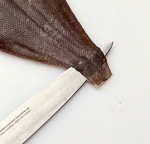
1 
2 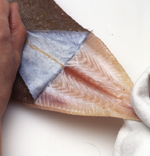
3 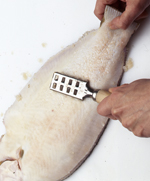
4 
5 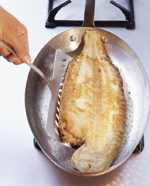
6 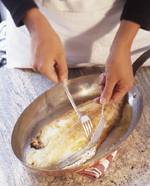
7 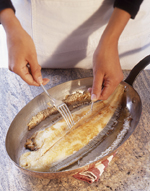
8 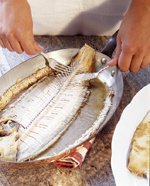
9 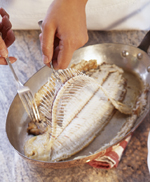
10 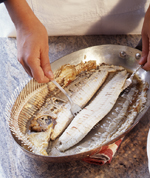
11 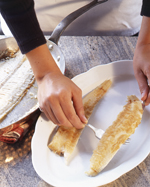
12 
13 
14
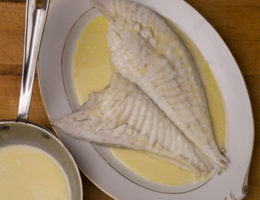


How do you know if you are truly getting Dover Sole at a restaurant. I am often very skeptital. How does one let the restaurant know of your concern? Can a small piece of “Dover Sole” be tested.
Thank you,
Peter Imbrogno
Sorry for the long delay. I can tell if I’m getting the real thing because the flesh is firm. If it sort of “melts” when you press on it with a fork, then it’s likely flounder. (All so-called sole in America is actually flounder.)
Dear James,
I thought your recipes for Dover Soles were very nice, and will cook a sole meunière at the first opportunity (I am in Spain for another 3 x weeks). As it has been my favourite fish since childhood, I have no difficulty recognising the genuine fish.
One piece of advice I would welcome is what the ‘correct’ English etiquette is when dining on Dover Sole if the fish has not been filleted or boned, and you’re presented with the whole divine fish.
I’d appreciate your comments.
Thanks, Yvonne
I once saw a recipe for Flounder. Take a Flounder and place it in a large pan. Fill the pan with a good quality white wine vinegar to cover the fish by about 2 inches. Add a few black peppercorns, some parsley stalks, a bay leaf and a few twists of sea salt. Bring the vinegar to the boil then simmer for 3 hours. Remove the pan from the heat then carefully lift out the flounder and discard it in a sealed bin. Once the vinegar has cooled drink it slowly.